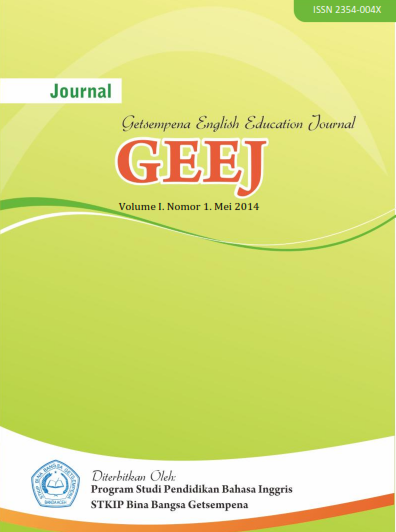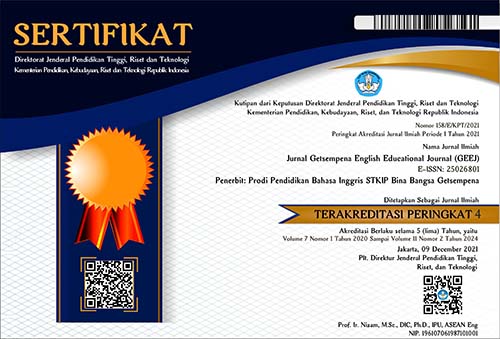AN OVERVIEW OF THE IMPLEMENTATION OF PRE-QUESTIONING STRATEGY IN TEACHING READING
Abstract
In reading, to comprehend the text the readers should be able to manage every part of the text, because it is easy to gain the comprehension in reading when the readers are able to organize the text. Sometimes, they may find form of pre-questioning and it is important for them to comprehend a reading text with having knowledge in general view of the text. Theoretically, pre-questioning itself can build the students’ interest and motivation before students read the whole text. Moreover, the students can predict what will be discussed on the text. In line with this study, students may improve their reading comprehension if they know about pre-questioning and it is very important to understand about pre-questioning in order to get good comprehension in reading. Based on the explanation above, it is interested to figure out an overview of the effect pre-questioning in teahing reading comprehension and to know the rule of pre-questioning that tends to build the students’ interest and motivation to read the text.
References
Alderson, J. C. (1996). “The Testing of Reading”. In C. Nuttall (Ed.), Teaching Reading Skills in a Foreign Language (pp. 212-28). Oxford: Mcmillan Heinemann.
Arda, E. (2000). The Role of Content Schema Related Pre-Reading Activities. Unpublished MA Thesis, Istanbul University, Turkey.
Arikunto, S. (2006). Prosedur Penelitian Suatu Pendekatan Praktik. Jakarta: Rineka Cipta.
Basuki, S. (2006). Metode Penelitian. Jakarta: Wedatama Widya Sastra dan Fakultas Ilmu Pengetahuan Budaya Universitas Indonesia.
Brown, H. D. (2004). Language Assessment Principles and Classroom Practices. New York: Longman.
Carrell, P. (1988). Interactive Approaches to Second Language Learning. London : Longman.
Coady, B (1989). Strategy in Reading. New York: Oxford University Press.
Cook, V. (2001). Second Language Learning and Language Teaching (3rd ed.). New York: Arnold Publication.
Cooper, J. D. (1986). Improving Reading Comprehension. Boston: Houghtonmiffin Company.
Cotton, P. (1992). Reading English Language Test. New York: Arnold Publication.
Dechant, E. (1973). Reading Improvement in the Secondary School. Englewood Cliffs (New Jersey): Prentice Hall.
Djiwandono, P. I. (2002). Strategi Membaca Bahasa Inggris. Jakarta : PT. Gramedia Pustaka Utama.
Douglas C., Montgomery. (1997). Design and Analysis of Experiments (4th edition). New York: John Wiley & Sons.
Grabe, W. and Stoller, F. L. (2001). “Reading for Academic Purposes: Guidelines for the ESL/EFL Teachers”. In M.
Celce-Murcia (Ed). Teaching English as a Second or Foreign Language (3rd ed.), (pp. 187-203), Boston: Heinle and Heinle.
Grellet, F. (1981). Developing Reading Skills: A Practical Guide to Reading Comprehension Exercises. Cambridge: CPU.
Hancock, O. (1987). Reading Skills for College Students. Englewood Cliffs (New Jersey): Prentice-Hall Inc.
Harmer, J. (2000). How to Teach English. (6th ed.). New York: Longman.
Hatch, E. and Farhady, H. (1982). Research Design and Statistics for Applied Linguistics. Rowley, MA: Newbury House.
Huerta-Maci'as, A. (2002). “Alternative Assessment: Responses to Commonly Asked Questions”. In J. C. Richards, & W. A. Renandya (Eds). Methdology in language teaching: An anthology of current practice (pp. 338-343), Cambridge: Cambridge University Press.
Jonston, K. (1987). Testing in Reading. New York: Oxford University Press.
Kahayanto. E.( 2005). A Comparative Study on Students’ Achievement in Reading I of the Education Study Program of Palangkaraya University who Entered Through PSB and SPMB in Academic Year 2003/2004.
Unpublished Thesis. Palangka Raya: The Faculty of Teacher Training and Education University of Palangka Raya.
Kee, L. (1997). How to Teach Reading Skill. Cambridge: Cambridge University Press.
Kustaryo, S. (1988). Reading Techniques or College Students. Jakarta : p2lptk.
Louse, C. M. (1999). Teaching Reading is Rocket Science. Washington D.C: AFT teacher.
Madsen, H. (1983). Techniques in Testing. New York: Oxford University Press.
Murcia (Ed). Teaching English as a Second or Foreign Language (3rd ed.), (pp. 153-169), Boston: Heinle and Heinle.
Nunan, D. (1989). Designing Tasks for the Communicative Classroom. Cambridge: Cambridge University Press.
Nuttall, L.C. (1998). Teaching Reading Skills in Foreign Language. Oxford: Mcmillan Heinemann.
Royer, J.M., Bates, J.A and Konold, C.E. (1983). “Learning from Text : Methods of Affecting Reader Intent”. In Alderson J.C. and A.H.Urquant (eds). Reading in a Foreign Language. London : Longman, 65-85.
Singer, H. (1978). “Active Comprehension: From Answering to Asking Questions”. The Reading Teacher, 31(8), 901–908. Newark, DE: International Reading Association.
Sudjana. (2002). Metode Statistika, Edisi 5. Bandung: Tarsito.
Surachmad, W. (1990). Manajemen Penelitian. Jakarta: Raja Grafindo Persada.
Taglieber, L.K., Johnson, L.L., & Yarbrough, D.B. (1988). “Effects of Prereading Activities on EFL Reading by Brazilian College Students”. TESOL Quarterly, 22, 455-472.
Turner, M. (1988). Language Teaching Methodology. London : Phoenix ELT.
Vacca, R. T., & Vacca, J. L. (2002). Content Area Reading: Literacy and Learning across the Curriculum (7th ed.). Boston: Allyn & Bacon.
Vacca, J.A, Vacca, R. and Gove, M.K. (2000). Reading and Learning to Read. New York: Longman.
Weir, C. J. (1997). “The Testing of Reading Second Language”. Encyclopedia of Language and Education,7, (pp.39-48). Dordrecht: Clawer Academic Publishers.

























